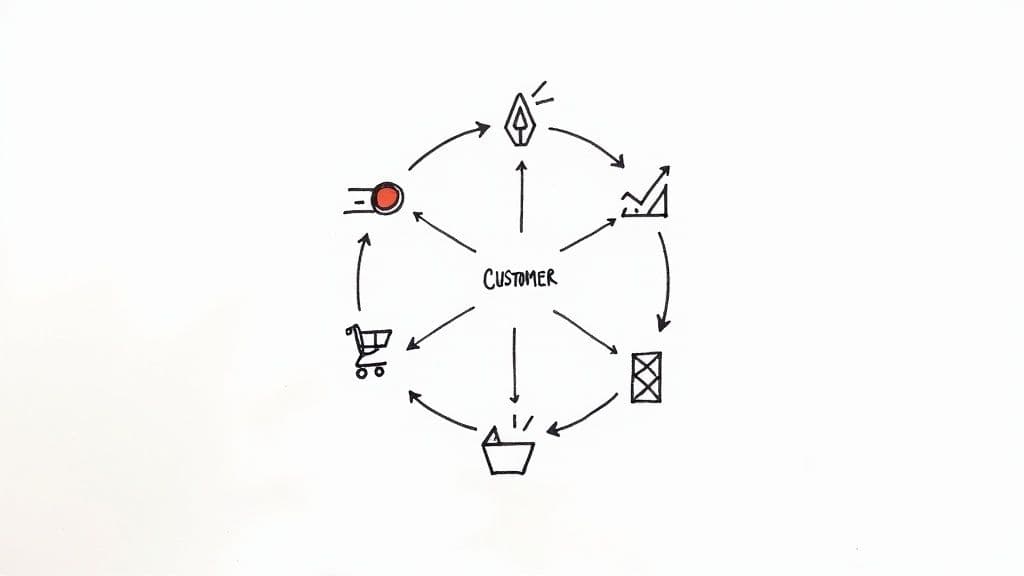In today's competitive market, acquiring a new customer is only the start. The real opportunity for sustainable growth lies in managing the entire relationship, from initial awareness to loyal advocacy. This strategic approach, known as customer lifecycle management (CLM), moves beyond simple transactions to build lasting, valuable relationships that are crucial for any digital business, from online course creators to subscription service providers.
Effective CLM isn't just about sending a well-timed email. It's a holistic framework that integrates data, technology, and human insight to deliver personalised, seamless experiences at every touchpoint. Mastering this process is the difference between a revolving door of one-time buyers and a thriving, engaged community of long-term supporters. A fundamental step in this process involves visually outlining every interaction a customer has with your brand. Exploring practical customer journey mapping examples can provide invaluable insights for building this foundational understanding.
This guide moves past theory to deliver concrete strategies you can implement immediately. We will explore eight proven customer lifecycle management best practices, breaking down complex concepts into actionable steps. You will learn how to segment your audience, orchestrate automated journeys, integrate customer feedback, and proactively manage retention. Each section provides practical implementation details designed to help you transform your customer interactions into a powerful engine for growth and loyalty in 2025 and beyond.
1. Customer Segmentation and Persona Development
The foundation of any successful customer lifecycle management strategy is understanding that your audience is not a monolith. Customer segmentation is the practice of dividing your customer base into distinct groups based on shared characteristics. This allows you to move beyond generic, one-size-fits-all communication and deliver highly relevant, personalised experiences that resonate with specific needs and behaviours.
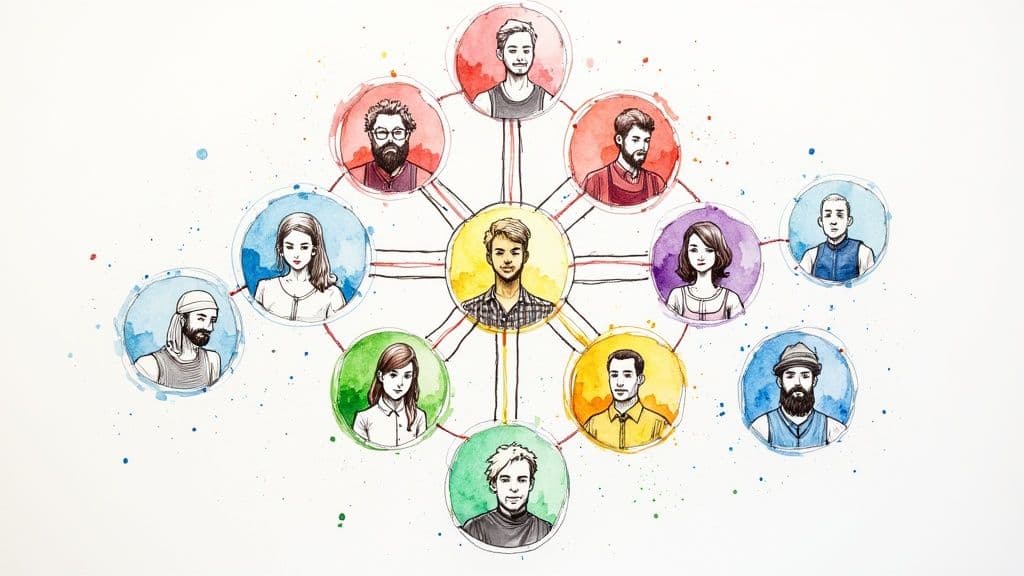
1a3c0142-5d23-4926-9831-acb75878fd3e.jpg
This approach is crucial because a new lead requires a different message than a loyal, repeat customer. By segmenting, you can tailor your marketing, product offerings, and support interactions to where each customer is in their journey with your brand. The ultimate goal is to create detailed buyer personas: semi-fictional representations of your ideal customers within each segment. For a deeper dive into this process, consider exploring resources on defining buyer personas.
Why This Practice is Foundational
Segmentation and personas are fundamental to customer lifecycle management best practices because they inform every subsequent action. They enable you to send targeted welcome series to new subscribers, offer specific up-sells to engaged users, and run re-engagement campaigns for those at risk of churning.
Consider the sophisticated model used by Netflix. The platform doesn't just know you like "action films"; it segments viewers based on viewing history, time of day they watch, and even the actors they follow, creating hyper-personalised "taste clusters" to recommend new content with remarkable accuracy. This level of detail keeps users engaged and subscribed.
Actionable Implementation Tips
To effectively integrate segmentation into your strategy, follow these steps:
- Start Simple, Then Layer: Begin with broad categories like demographics (age, location) and psychographics (interests, values). Gradually layer on behavioural data, such as purchase history, feature usage within your app, or content engagement levels.
- Map Segments to the Lifecycle: Identify which segments correspond to each stage of the lifecycle: awareness, consideration, purchase, retention, and advocacy. A "new subscriber" segment is in the early stages, while a "repeat buyer" is in the retention phase.
- Utilise Your Tools: Leverage your CRM or marketing automation platform to create dynamic segments that automatically update as customer behaviour changes. For instance, a customer can move from a "first-time buyer" segment to a "loyal customer" segment after their third purchase.
- Validate and Refine: Customer behaviour and market trends change. Regularly review your segments (quarterly or bi-annually) to ensure they are still accurate and relevant. Use A/B testing on different segments to see which messaging resonates most.
2. Omnichannel Customer Experience Integration
A truly effective customer lifecycle management strategy must break down the silos between channels. Omnichannel customer experience integration is the practice of creating a seamless, consistent, and unified brand experience across every single touchpoint. Whether a customer is browsing on your website, using your mobile app, engaging on social media, or speaking to a support agent, their journey should feel like a single, continuous conversation with your brand.
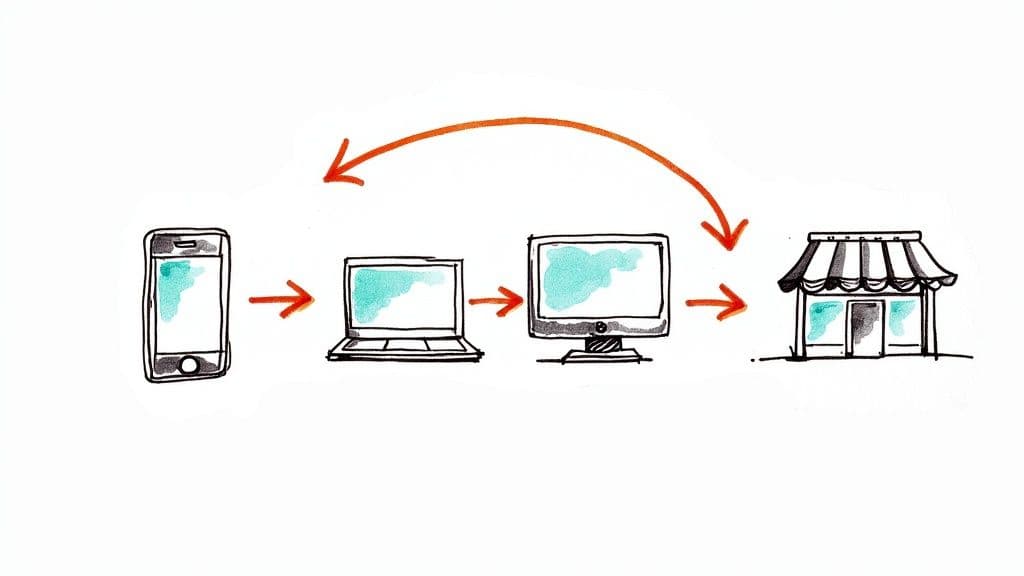
59ca3b1d-2174-48e4-8e1f-9a71c9a0fb8a.jpg
This approach moves beyond multi-channel, where channels exist in parallel, to omnichannel, where they are fully interwoven. It ensures that context and history travel with the customer, preventing them from having to repeat information and creating a smoother, more intuitive experience. The goal is to make channel-switching effortless for the customer, reflecting how they naturally interact in a digital-first world.
Why This Practice is Foundational
Omnichannel integration is fundamental because modern customer journeys are not linear; they are fluid and unpredictable. Customers expect to start a purchase on their phone, research it on their laptop, and perhaps complete it via a chatbot, all without friction. Without an integrated view, you risk delivering disjointed and frustrating experiences that can push customers away at any stage of the lifecycle.
Consider the Starbucks Rewards app. A customer can order and pay on their mobile, earn loyalty points, receive personalised offers, and then pick up their drink in-store. The digital and physical experiences are perfectly synchronised, making the process convenient and rewarding. This level of integration strengthens loyalty and encourages repeat business, a cornerstone of effective retention strategies.
Actionable Implementation Tips
To build a true omnichannel experience, follow these steps:
- Map the Customer Journey: Start by comprehensively mapping every possible customer interaction and touchpoint across all your channels. Identify where handoffs between channels occur and pinpoint potential friction points.
- Invest in a Centralised CRM: A robust Customer Relationship Management (CRM) system is non-negotiable. It must act as a single source of truth, integrating data from your website, app, social media, and support platforms to create a unified customer profile.
- Train Your Teams: Ensure all customer-facing staff, from marketing to sales to support, are trained on using the unified customer view. They must understand the importance of delivering a consistent brand experience regardless of the channel.
- Roll Out Gradually: Don't try to integrate everything at once. Start with connecting two high-traffic channels, like your website and email support. Test, gather feedback, refine the process, and then gradually expand to other touchpoints.
3. Predictive Analytics and Customer Lifetime Value Modelling
Moving beyond historical data, this practice involves using advanced analytics and machine learning to forecast future customer behaviours. By applying statistical models, you can predict which customers are likely to make a repeat purchase, which are at risk of churning, and what the total long-term value of each customer relationship will be. This empowers you to be proactive rather than reactive, allocating resources to high-value segments and intervening before a customer decides to leave.
This infographic outlines the core process of using predictive insights to segment customers based on their future value.
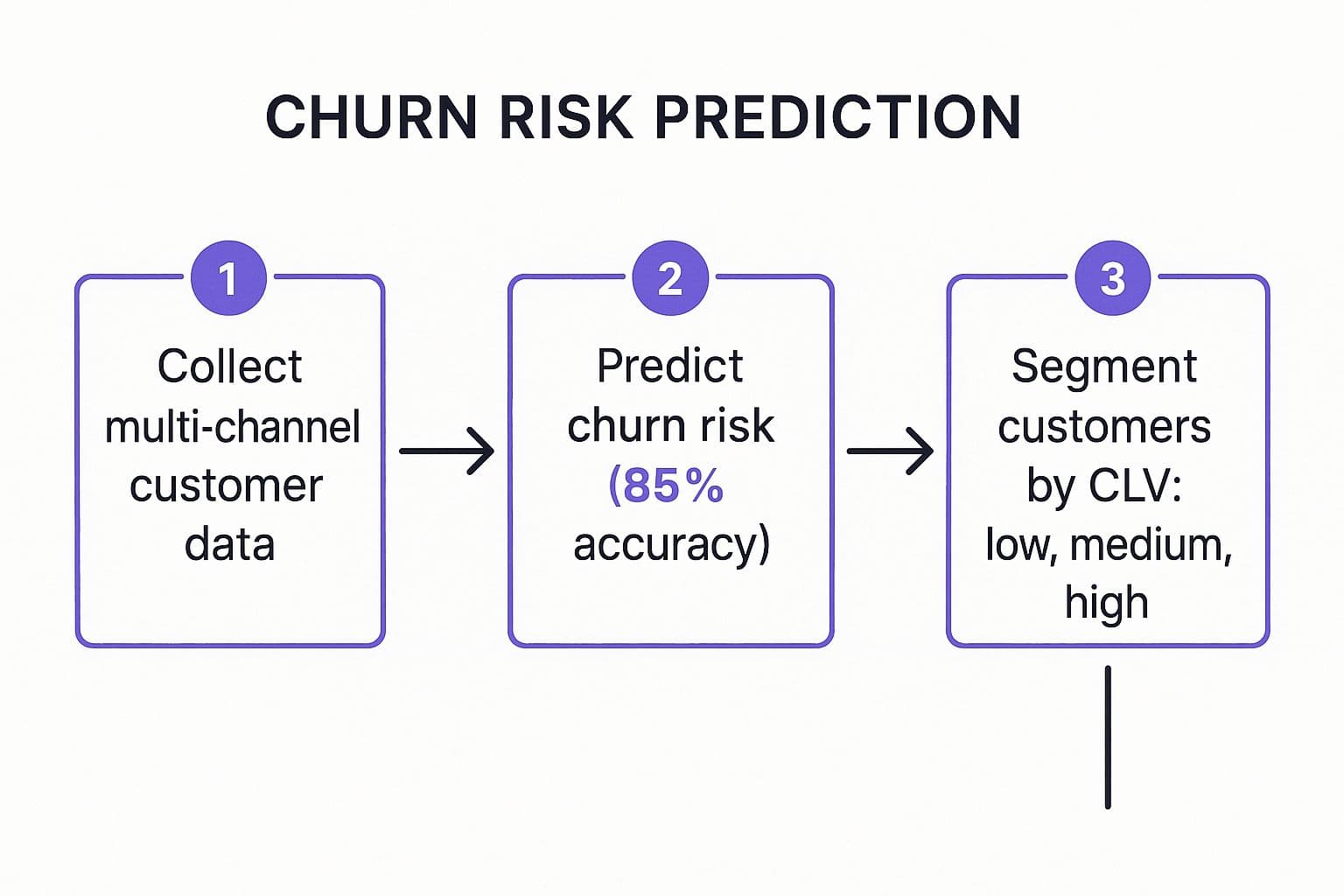
infographic-31e2d091-0dfc-4ac3-a597-8ba72a9f757b.jpg
This streamlined workflow allows you to transition from raw data collection to a highly targeted, value-driven segmentation strategy with quantifiable accuracy.
This forward-looking approach is a cornerstone of modern customer lifecycle management best practices. For instance, American Express uses sophisticated models to detect fraudulent transactions before they are completed and to assess customer risk, protecting both the company and its members. Similarly, Airbnb predicts booking likelihood and suggests optimal pricing to hosts, directly influencing revenue and customer satisfaction. The goal is to make informed, data-driven decisions that maximise long-term profitability.
Why This Practice is Foundational
Predictive modelling is fundamental because it shifts your strategy from reacting to past events to anticipating future outcomes. It provides the intelligence needed to personalise interactions at scale, ensuring you invest your marketing budget and support efforts where they will generate the greatest return. By identifying high-potential customers early, you can nurture them into brand advocates, significantly boosting their lifetime value.
Consider Netflix’s dual use of predictions. The platform not only recommends content you are likely to enjoy but also uses predictive analytics to inform which original series to produce, green-lighting projects with a high probability of retaining specific subscriber segments. This proactive content strategy is a key driver of its low churn rate and market dominance.
Actionable Implementation Tips
To effectively leverage predictive analytics in your customer lifecycle management, follow these steps:
- Ensure Data Quality: Your predictions are only as good as your data. Before building any models, ensure your data from various sources (CRM, website analytics, purchase history) is clean, consistent, and integrated.
- Start Simple and Iterate: Begin with basic predictive models, such as identifying customers who haven't engaged in 30 days. As you gather more data and expertise, you can develop more complex models for churn prediction or calculating Customer Lifetime Value (CLV). For a practical starting point, you can explore tools like a lifetime value calculator.
- Focus on Actionable Insights: A prediction is useless without a corresponding action. Ensure every model provides a clear insight that your team can act upon, for example, "customers who use Feature X but not Feature Y are 80% likely to churn next month."
- Combine AI with Human Judgement: Use predictive insights to empower your team, not replace them. Allow your customer success managers to use churn risk scores to prioritise their outreach efforts, combining data with their personal knowledge of the customer relationship.
4. Automated Customer Journey Orchestration
Automated customer journey orchestration is a sophisticated approach that moves beyond simple, linear email sequences. It involves using automation tools and workflows to deliver personalised, timely interactions based on specific customer behaviours and their current lifecycle stage. This practice enables the creation of dynamic, branching customer journeys that adapt in real-time, ensuring every communication is relevant and delivered at the most impactful moment.
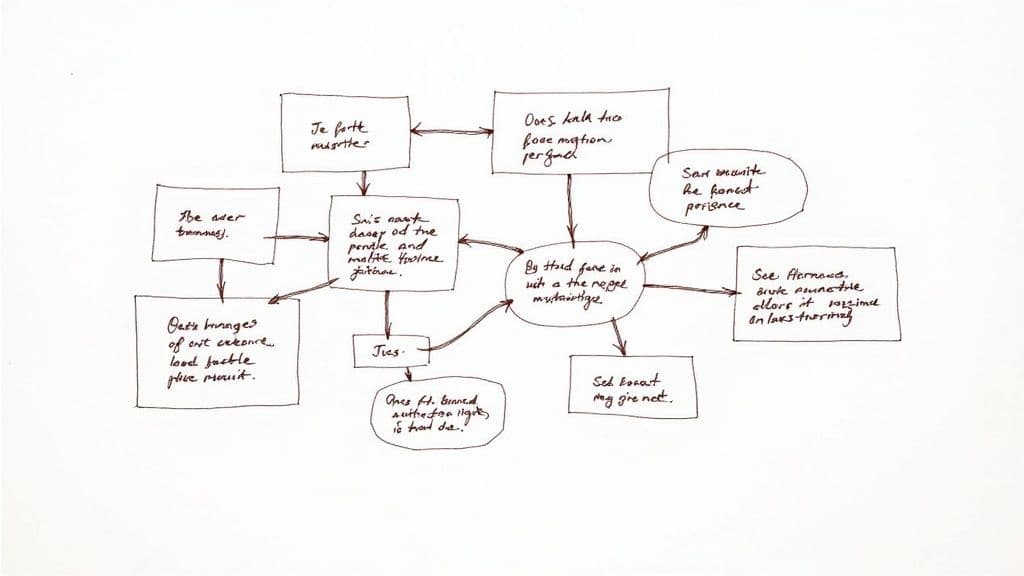
b5cf1b4c-d8e9-49aa-ba26-7df1f0919185.jpg
This method ensures that if a customer opens an email, clicks a specific link, or visits a pricing page, their journey immediately adjusts to reflect that action. Instead of sending a generic follow-up, the system can trigger a targeted message related to their demonstrated interest. To truly optimise the customer journey and improve efficiency, it's crucial to understand proven customer service automation strategies that drive results.
Why This Practice is Foundational
Automated orchestration is a core component of modern customer lifecycle management best practices because it scales personalisation. It allows you to manage thousands of individual customer pathways simultaneously without manual intervention, ensuring no customer is left behind. This proactive, responsive communication deepens engagement and accelerates progression through the lifecycle.
Consider Shopify's abandoned cart sequences. When a user adds an item to their cart but doesn't complete the purchase, an automated workflow is triggered. This isn't just one email; it’s a multi-step journey that might include a simple reminder, followed by an email showcasing customer reviews for that product, and perhaps a final offer of a small discount to incentivise the purchase. Each step is a reaction to the customer’s (in)action, making the interaction feel helpful rather than intrusive.
Actionable Implementation Tips
To effectively orchestrate customer journeys, follow these steps:
- Map Before You Build: Before touching any automation software, visually map out every potential customer journey. Use flowcharts to define triggers, actions, and decision points (e.g., if email opened, send X; if not opened, send Y).
- Start Simple and Scale: Begin with a single, high-impact journey, such as a welcome series for new subscribers or an onboarding sequence for new clients. Once you have optimised its performance, you can build more complex, multi-channel workflows.
- Provide an 'Opt-Down' Option: Always include options for customers to manage their communication preferences. Instead of just an "unsubscribe" button, allow them to opt down from daily to weekly updates or choose the types of content they receive.
- Review and Optimise Relentlessly: Automation is not a "set and forget" tool. Regularly analyse performance metrics like open rates, click-through rates, and conversion rates for each stage of your automated workflows. A/B test different messages, timings, and offers to continually improve results.
- Maintain Human Oversight: Ensure there are clear pathways for a customer to connect with a human team member if the automated journey fails to address their needs. This is critical for handling complex queries and preventing customer frustration.

embed
5. Voice of Customer (VoC) Integration and Feedback Loop Management
Truly effective customer lifecycle management isn't just about what you say to customers; it's about what they say back to you. Integrating the Voice of the Customer (VoC) means systematically collecting, analysing, and, most importantly, acting on customer feedback at every stage of their journey. It transforms customer input from a passive data point into an active driver of business strategy and improvement.
This practice involves creating structured processes to capture insights, measure sentiment through metrics like Net Promoter Score (NPS), and use that data to refine your products, services, and communications. The goal is to establish a continuous feedback loop where customers feel heard, and their input visibly shapes the business, fostering deeper loyalty and trust. This is a core pillar of modern customer lifecycle management best practices, as it directly informs how you can better serve each segment.
Why This Practice is Foundational
A robust VoC programme is fundamental because it provides the "why" behind customer behaviour. While analytics can show you what customers are doing, VoC tells you why they are doing it, revealing pain points, unmet needs, and opportunities for delight. It allows you to be proactive rather than reactive, addressing potential issues before they lead to churn and identifying what loyal customers value most.
Take Slack, for example. The platform’s evolution has been heavily guided by user feedback. Features like threaded conversations, user statuses, and integrations were often developed in direct response to requests and pain points articulated by its community. This feedback-driven approach ensures the product evolves in line with user needs, which is crucial for retaining subscribers in a competitive market.
Actionable Implementation Tips
To embed VoC into your customer lifecycle strategy, follow these steps:
- Use Multiple Feedback Channels: Don't rely solely on one method. Combine surveys (like NPS or CSAT), in-app feedback forms, social media listening, and direct interviews to capture a diverse range of customer voices across different touchpoints.
- Implement Real-Time Collection: Trigger feedback requests at key moments. Ask for input immediately after a purchase, a support interaction, or after a customer has used a new feature for the first time to gather timely, context-rich insights.
- Establish a Clear Internal Process: Create a system for categorising, routing, and prioritising feedback. Ensure insights from support tickets are shared with the product team, and survey results are reviewed by marketing and leadership.
- Always Close the Loop: This is the most critical step. Acknowledge the feedback and, where possible, inform customers how their input was used. A simple email saying, "You asked, we listened. We've now added [feature] based on your feedback," can turn a customer into a powerful advocate.
6. Customer Success and Proactive Retention Management
A modern customer lifecycle management strategy must shift from a reactive support model to a proactive success framework. Customer success is a business methodology focused on ensuring customers achieve their desired outcomes while using your product or service. Rather than waiting for a problem to arise, this approach involves actively guiding and supporting users to maximise the value they receive, thereby preventing churn before it even becomes a risk.
This practice is centred on a partnership. It moves the customer relationship beyond a simple transaction to a collaborative effort where your success is intrinsically linked to theirs. For online course creators or fitness coaches, this means actively monitoring student progress or client milestones, not just answering support tickets. This proactive engagement is a cornerstone of effective retention and turns satisfied users into powerful brand advocates.
Why This Practice is Foundational
Customer success is fundamental to long-term profitability, especially in subscription-based models common among digital educators and community owners. Acquiring a new customer is far more expensive than retaining an existing one. Proactive retention management directly addresses this by identifying and mitigating churn risks early, ensuring a stable and predictable revenue stream.
Consider the approach popularised by software giants like Salesforce. They don't just sell software; they provide extensive learning platforms (like Trailhead) and dedicated customer success managers who ensure businesses are using the tool effectively to achieve their goals. Similarly, Slack's customer success teams proactively engage with new enterprise clients to drive adoption and highlight key features, ensuring the tool becomes indispensable to their daily workflow. This deep integration is a powerful defence against churn.
Actionable Implementation Tips
To embed proactive retention into your customer lifecycle management, focus on these steps:
- Define Success Metrics: Work with your customers to understand what "success" looks like for them. Is it completing a course module, hitting a fitness goal, or achieving a certain level of engagement in a community? Define these outcomes clearly.
- Implement Early Warning Systems: Use your platform's analytics to monitor customer health. Track metrics like login frequency, feature usage, and content completion rates. A sudden drop in activity can trigger a proactive outreach from your team.
- Structure for Quick Wins: Design your onboarding process to deliver immediate value. A new member of your community or a new student in your course should experience a "win" early on, reinforcing their decision to join you.
- Develop Success Playbooks: Create standardised processes for common scenarios. Develop playbooks for onboarding, low engagement, and upselling opportunities. This ensures consistent and effective interactions across your customer base. For more strategies on this, you can explore detailed guides on how to reduce your churn rate.
7. Data-Driven Customer Health Monitoring and Scoring
Proactively managing the customer lifecycle requires moving beyond reactive problem-solving. Data-driven customer health monitoring is a systematic approach to evaluating customer engagement, satisfaction, and relationship strength. It involves creating a composite "health score" from multiple data points, providing early warning signals of potential churn and highlighting opportunities for deeper engagement.
This practice allows you to quantify the status of your customer relationships in a consistent, scalable way. Instead of guessing which customers are at risk, you can use data to identify them and intervene with targeted actions. For example, a low health score might trigger an automated check-in email from a success manager or an offer for a one-on-one training session. This proactive stance is a cornerstone of modern customer lifecycle management best practices.
Why This Practice is Foundational
Customer health scoring is fundamental because it transforms customer management from an art into a science. It provides a clear, objective metric that your entire organisation, from sales to support, can understand and act upon. This prevents valuable customers from quietly disengaging and churning without any warning.
Consider how a platform like Dropbox monitors user health. It doesn't just track if you log in; it looks at file uploads, sharing activity, and collaboration within teams. A sudden drop in these activities for a business account signals a low health score, prompting the customer success team to investigate whether the team is facing challenges or considering a competitor. This data-driven insight allows for timely intervention before the account is lost.
Actionable Implementation Tips
To effectively implement customer health monitoring, follow these steps:
- Start Simple, Then Add Complexity: Begin by tracking 2-3 key metrics that strongly correlate with retention, such as product usage frequency, recent login activity, or support ticket volume. As you gather data, you can layer in more nuanced indicators like feature adoption rates or survey responses.
- Combine Behavioural and Sentiment Data: A truly comprehensive health score blends what customers do with what they say. Combine behavioural metrics (e.g., usage data from Mixpanel) with sentiment data from satisfaction surveys (like Net Promoter Score) to get a complete picture.
- Validate Scores Against Outcomes: Regularly check if your health scores are accurate predictors. For instance, analyse whether customers with "poor" health scores over the past six months actually had a higher churn rate. Use this feedback to refine your scoring model.
- Make Scores Actionable: A health score is useless if it doesn't lead to an action. Define clear playbooks for each health status. A "healthy" score might trigger an upsell offer, while a "declining" score initiates a retention campaign. This ensures your insights are translated into tangible business results.
8. Lifecycle-Based Content and Communication Strategy
A one-size-fits-all content strategy is ineffective in a sophisticated customer journey. A lifecycle-based content and communication strategy is the practice of creating and delivering targeted messaging that precisely aligns with where a customer is in their journey with your brand. This means moving beyond generic newsletters and developing stage-appropriate content, from awareness-building blog posts to advocacy-driving case study requests.
This approach is centred on providing value at every touchpoint. The content sent to a brand-new subscriber should educate and welcome them, while the communication for a long-term, loyal user should focus on advanced features, exclusive benefits, and community building. By tailoring your messaging, you guide customers seamlessly from one stage to the next, strengthening their relationship with your brand and preventing disengagement.
Why This Practice is Foundational
This strategy is fundamental to effective customer lifecycle management best practices because content is the primary vehicle for communication. Without aligning content to the lifecycle stage, your messages risk being irrelevant, premature, or too late, leading to confusion and churn. Stage-specific content demonstrates that you understand your customers' needs and are committed to helping them succeed at every step.
HubSpot is a master of this, offering a vast library of educational content that caters to everyone from a novice marketer (awareness) to a seasoned professional looking to maximise their CRM (retention and advocacy). Their content isn't just a marketing tool; it's a core part of their product experience, designed to help users grow alongside the platform. This builds immense trust and positions them as an indispensable partner.
Actionable Implementation Tips
To effectively implement a lifecycle-based content strategy, follow these steps:
- Create a Lifecycle Content Map: Visually map out the customer lifecycle stages (e.g., Awareness, Consideration, Purchase, Retention, Advocacy) and brainstorm the key questions, goals, and challenges customers have at each one. Then, align specific content formats (e.g., blog posts, webinars, tutorials, case studies) to address those needs.
- Implement Progressive Profiling: Don't ask for all customer information at once. Use forms and interactions to gradually gather data over time. This allows you to enrich customer profiles and deliver increasingly personalised content as you learn more about their preferences and goals.
- Test and Measure with Lifecycle Metrics: Don't just track opens and clicks. Measure content performance using lifecycle-specific metrics. For example, for an onboarding sequence, track product adoption rates. For retention content, monitor churn reduction and repeat purchase rates.
- Use Feedback to Fuel Your Content Engine: Actively solicit feedback from customers at different stages to understand their pain points and interests. This qualitative data is invaluable for generating relevant content ideas that truly resonate and for learning more about how to keep members engaged.
Customer Lifecycle Management Best Practices Comparison
| Item | Implementation Complexity 🔄 | Resource Requirements ⚡ | Expected Outcomes 📊 | Ideal Use Cases 💡 | Key Advantages ⭐ |
|---|---|---|---|---|---|
| Customer Segmentation and Persona Development | Moderate to high; requires data collection and analysis | High; needs cross-channel data and analytics tools | Increased marketing relevance, higher conversions | Targeted marketing, personalized customer engagement | Better resource allocation, improved retention |
| Omnichannel Customer Experience Integration | Very high; complex integration and change management | Very high; systems integration and training | Seamless, consistent customer experience across channels | Unified brand experience across mobile, web, social, in-person | Higher customer satisfaction, operational efficiency |
| Predictive Analytics and Customer Lifetime Value Modeling | High; advanced analytics and model maintenance | High; requires data science and quality data | Proactive retention, optimized marketing spend | Predicting behavior, prioritizing high-value customers | Enables data-driven decisions, reduces acquisition cost |
| Automated Customer Journey Orchestration | High; complex automation workflows | Moderate to high; automation tools and monitoring | Consistent, timely communications, increased engagement | Personalized lifecycle communications at scale | Reduces manual work, scalable personalization |
| Voice of Customer (VoC) Integration and Feedback Loop Management | Moderate; process implementation and system setup | Moderate; feedback systems and analytics | Improved satisfaction, data-driven improvements | Continuous feedback collection and action | Direct customer insights, early problem detection |
| Customer Success and Proactive Retention Management | High; requires people, technology, and processes | High; investment in teams and customer monitoring | Reduced churn, higher lifetime value | Customer outcomes focus, proactive churn prevention | Increased advocacy, better adoption |
| Data-Driven Customer Health Monitoring and Scoring | Moderate to high; data collection and scoring complexity | High; data infrastructure and analytics | Early risk detection, objective customer health | Tracking engagement and satisfaction for proactive intervention | Prioritized resource allocation, actionable insights |
| Lifecycle-Based Content and Communication Strategy | Moderate; content creation and lifecycle management | High; content resources and management | Higher engagement, better conversion rates | Stage-based customer communication and education | Timely relevant content, reduced unsubscribe rates |
Putting Your Customer Lifecycle Strategy into Action
We have journeyed through the critical stages and foundational pillars of effective customer lifecycle management, from initial segmentation and omnichannel integration to sophisticated data analysis and proactive retention. It is clear that mastering this discipline is not about implementing a single, magical tactic. Instead, it is a strategic commitment to understanding, serving, and evolving with your customers at every touchpoint. Adopting these customer lifecycle management best practices is the blueprint for transforming your business from a transactional entity into a relational ecosystem.
The eight practices we explored - granular segmentation, omnichannel integration, predictive analytics, journey orchestration, VoC feedback loops, proactive success management, data-driven health scoring, and lifecycle-based content - are not isolated strategies. They are interconnected gears in a larger machine. Your customer health scores should inform your proactive retention efforts, while your VoC data must continuously refine your customer personas and automated journey orchestrations. The power lies in their synergy.
From Theory to Tangible Results
The core takeaway is this: a successful lifecycle strategy is both a science and an art. It demands a rigorous, data-driven approach to measurement and optimisation, yet it also requires a deeply empathetic understanding of the human beings who make up your customer base. It’s about more than just reducing churn; it's about maximising value, both for your business and for the customer.
Consider the practical implications. For a digital coach, implementing a lifecycle-based content strategy means sending advanced workout plans to long-term members, while providing foundational nutritional guides to newcomers. For an online course creator, using proactive success management could involve an automated check-in email for students who haven't logged in for a week, offering help and encouragement. These are the small, deliberate actions that cultivate loyalty.
Your Actionable Next Steps
Embarking on this journey can feel overwhelming, but progress is made through incremental, consistent effort. Don't attempt to overhaul everything at once. Instead, identify the area of your customer lifecycle that needs the most immediate attention and start there.
- Conduct a Lifecycle Audit: Where are you strongest, and where are the most significant gaps? Are you brilliant at acquisition but poor at retention? Do you collect feedback but fail to act on it? A candid self-assessment is the essential first step.
- Prioritise One Practice: Select a single best practice to implement in the next 90 days. Perhaps it's setting up your first Voice of Customer survey or defining basic customer health scores. Focus on achieving a small, measurable win.
- Leverage Technology: Manually managing these processes is unsustainable as you grow. Explore and implement tools that can automate key touchpoints, centralise your data, and provide the insights you need to make informed decisions.
- Measure, Refine, Repeat: Treat your lifecycle strategy as a living document. Continuously monitor your key metrics, such as customer lifetime value (CLV), churn rate, and engagement scores. Use this data to refine your approach and adapt to your customers' changing needs.
Ultimately, investing in customer lifecycle management best practices is an investment in the long-term health and resilience of your business. It is the definitive shift from chasing fleeting transactions to building lasting, profitable relationships. The effort you dedicate today to understanding and nurturing your customers will compound over time, creating a loyal community of advocates who are the true foundation of sustainable growth.
Ready to automate the administrative side of your customer lifecycle so you can focus on building your community? MyMembers provides the essential tools for Telegram creators to manage subscriptions, automate access, and streamline payments, freeing you up to implement these high-impact strategies. Explore how MyMembers can become the engine for your customer management today.
